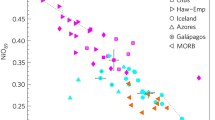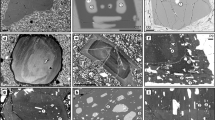Abstract
Statistical study of volcanic rocks from oceanic islands and seamounts in the Atlantic Ocean based on approximately 6000 analyses (data from the authors’ databank) makes it possible to recognize rocks close to the parental melts (approximately 2000 analyses). This set is demonstrated to include a unique group of high-potassium (K2O/Na2O > 1) rocks, whose K2O/Na2O ratio is several times higher than in the mantle and calls for the explanation of the mechanism that increased the K2O concentration during the melting of the mantle and for the identification of an additional K2O source in the mantle and a process responsible for K and Na differentiation. A new model is proposed to account for the genesis of high-potassium melts-fluids, whose ascent brings about extensive mantle metasomatism. The genesis of high-potassium fluid is related to solid-state reactions at deep mantle levels.
Similar content being viewed by others
References
P. W. Gast, “Trace Element Fractionation and the Origin of Tholeiitic and Alkaline Magma Types,” Geochim. Cosmochim. Acta 32, 1057–1086 (1968).
L. N. Kogarko and A. M. Asavin, “Regional Features of Primary Alkaline Magmas of the Atlantic Ocean,” Geokhimiya, No. 9, 915–932 (2007) [Geochem. Int. 45, 841–856 (2007)].
W. F. McDonough and S. Sun, “The Composition of the Earth,” Chem. Geol. 120, 223–253 (1995).
K. Asch, “The Geological Map: The Visual Language of Geologists (with Too Many Dialects for Even the Most Sophisticated Computers),” in Extended Abstracts of Conference GIS-in Geology (Moscow, 2002), p. 15.
J. B. Gill, Orogenic Andesites and Plate Tectonics (Springer, Berlin, 1981).
S. F. Foley, G. Venturell, D. H. Green, and L. Toscani, “The Ultrapotassic Rocks: Characteristics, Classification and Constraints for Petrogenetic Models,” Earth-Sci. Rev. 24, 81–134 (1987).
A. K. Gupta and W. S. Fyfe, The Young Potassic Rocks (Ane Books, New Delhi, 2003).
D. H. Green and A. E. Ringwood, “The Genesis of Basaltic Magmas,” Contrib. Mineral. Petrol. 15, 103–190 (1967).
R. C. Mitchell-Thome, Geology of the South Atlantic Islands (Berlin, 1970).
P. de Paepe, J. Klerkx, J. Hertogen, and P. Plinke, “Oceanic Tholeiites on the Cape Verde Islands: Petrochemical and Geochemical Evidence,” Earth Planet. Sci. Lett. 22, 347–354 (1974).
Igneous Rocks. A Classification and Glossary Sciences Subcommission on the Systematic of Igneous Rocks, Ed. by R. W. Le Maitre, (University Press, Cambridge, 2002).
M. J. Le Bas and A. L. Streckeisen, The IUGS Systematics of Igneous Rocks, J. Geol. Soc. London, 148, 825–833 (1991).
K. Putirka, “Clinopyroxene + Liquid Equilibria to 100 Kbar and 2450 K,” Contrib. Mineral. Petrol. 135, 151–163 (1999).
K. Putirka, “Garnet + Liquid Equilibrium,” Contrib. Mineral. Petrol. 11, 27–288 (1998).
I. D. Ryabchikov, T. Ntaflos, A. Büchl, and I. P. Solovova, “Subalkaline Picrobasalts and Plateau Basalts from the Putorana Plateau (Siberian Continental Flood Basalt Province). I. Mineral Compositions and Geochemistry of Major and Trace Elements,” Geokhimiya 39(5), 467–483 (2001) [Geochem. Int. 39, 415–431 (2001)].
J. Adam and T. H. Green, “The Effects of Pressure and Temperature on the Partitioning of Ti, Sr and REE between Amphibole, Clinopyroxene and Basanitic Melts,” Chem. Geol. 117, 219–233 (1994).
W. E. Gallahan and R. L. Nielsen, “The Partitioning of Sc, Y, and the Rare Earth Elements between High-Ca Pyroxene and Natural Mafic to Intermediate Lavas at 1 Atmosphere,” Geochim. Cosmochim. Acta 56, 2387–2404 (1992).
M. J. Walter, “Melting of Garnet Peridotite and the Origin of Komatiite and Depleted Lithosphere,” J. Petrol. 39(1), 29–60 (1998).
L. N. Kogarko, “Role of Deep-Seated Fluids in the Genesis of Mantle Heterogeneity and Alkali Magmatism,” Geol. Geofiz. 46(12), 1234–1245 (2005).
A. K. Gupta, K. Yagi, Y. Hariya, and K. Onuma, “Experimental Investigation of Some Synthetic Leucite-Rocks under Water Vapor Pressure,” Proc. Jap. Acad. Sci. 52, 469–472 (1976).
M. Arima and A. Edgar, “High Pressure Experimental Studies on a Katangite and Their Bearing on the Genesis of Some Potassium-Rich Magmas of the West Fracture of the African Rift,” J. Petrol. 24, 166–187 (1983).
Mantle Metasomatism, Ed. by M. A. Menzies and C. J. Hawkesworth (Academic, London, 1987).
S. F. Foley, “Vein-Plus-Wall-Rock Melting Mechanism in the Lithosphere and the Origin of Potassic Alkaline Magmas,” Lithos 28, 425–453 (1992).
N. V. Sobolev and V. S. Shatsky, “Diamond Inclusions in Garnets from Metamorphic Rocks: A New Environment for Diamond Formation,” Nature 4, 742–746 (1990).
O. Navon and E. S. Izraeli, “Cl- and K-Rich Micro-Inclusions in Cloudy Diamonds,” EOS, Trans. Am. Geophys. Union 80, F1128 (1999).
P. Schiano and B. Bourdon, “On the Preservation of Mantle Information in Ultramafic Nodules: Glass Inclusions within Minerals versus Interstitial Glasses,” Earth Planet. Sci. Lett. 169, 173–188 (1999).
L. A. Taylor, H. J. Milledge, G. P. Bulanova, et al., “Metasomatic Eclogitic Diamond Growth: Evidence from Multiple Diamond Inclusions,” Int. Geol. Rev. 40(8), 663–676 (1998).
G. Turner, R. Burgess, M. Laurenzi, et al., “Ar40-Ar39 Laser Probe Dating of Individual Inclusion in Diamonds,” Chem. Geol. 70 (1988).
R. Burgess, E. Layzelle, G. Turner, and J. W. Harris, “Constraints on the Age and Halogen Composition of Mantle Fluids in Siberian Coated Diamonds,” Earth Planet. Sci. Lett. 197 (2002).
E. S. Izraeli, J. W. Harris, and O. Navon, “Brine Inclusions in Diamonds: A New Upper Mantle Fluid,” Earth Planet. Sci. Lett. 187, 323–332 (2001).
E. M. Galimov, “Isotope Fractionation Related to Kimberlite Magmatism and Diamond Formation,” Geochim. Cosmochim. Acta 55, 1697–1708 (1991).
A. Corgne and B. J. Wood, “Trace Element Partitioning between Majoritic Garnet and Silicate Melt at 25 GPa,” Phys. Earth Planet. Int. 143-144, 407–419 (2004).
O. G. Safonov, L. L. Perchuk, and Yu. A. Litvin, “Effect of Carbonates on Crystallization and Composition of Potassium-Bearing Clinopyroxene at High Pressures,” Dokl. Akad. Nauk 408, 580–585 (2006) [Dokl. Earth Sci. 408, (2006)].
A. Corgne, C. Liebske, B. J. Wood, et al., “Silicate Perovskite- Melt Partitioning of Trace Elements and Geochemical Signature of a Deep Perovskitic Reservoir,” Geochim. Cosmochim. Acta 69(2), 485–496 (2005).
A. E. Ringwood, S. E. Kesson, W. Hibberson, and N. Ware, “Origin of Kimberlites and Related Magmas,” Earth Planet. Sci. Lett. 113, 521–538 (1992).
Author information
Authors and Affiliations
Corresponding author
Additional information
Original Russian Text © L.N. Kogarko, A.M. Asavin, 2009, published in Geokhimiya, 2009, No. 9, pp. 899–909.
Rights and permissions
About this article
Cite this article
Kogarko, L.N., Asavin, A.M. Oceanic potassic magmas: An example of the Atlantic Ocean. Geochem. Int. 47, 847–856 (2009). https://doi.org/10.1134/S0016702909090018
Received:
Published:
Issue Date:
DOI: https://doi.org/10.1134/S0016702909090018




